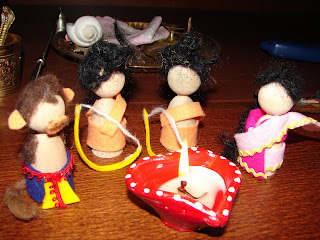In the Waldorf tradition, Martinmaas and colorful lanterns ask us to remember the light within. In India and places where people celebrate Vedic culture, this is a special month called Kartik. During Kartik, there are many festivals including a very popular one called Diwali.
Diwali is a celebration of where hundreds of lamps and candles, called diyas, are lit in homes, businesses, and temples. It is to commemorate a special day that happened hundreds of years ago when Prince Rama returned to be king of Ayodhya. Sri Rama rescues his kidnapped wife Sita from the wicked Ravana who was the king of what is known today as Sri Lanka. Prince Rama had also been exiled from Ayodhya for 14 years as a boon given to his stepmother Kaikeiyi. This is a magical story filled with monkeys, flying flower-airships, battles, and love and devotion. It is called the Ramayana and it's a well loved story in India and abroad.
I was lucky enough to participate in a Waldorf-inspired puppet show to celebrate Diwali at my daughter's kindergarten class. All the children watched with awe. One particular part they liked was when Rama goes to chase the golden deer that Sita asks for. My daughter was so happy to see Hanuman (Rama's most beloved and dedicated monkey friend). Each child was given a diya to take home. Children in a Waldorf school typically learn about the Ramayana in the 5th grade when studying world cultures.
Our Ramayana Finger puppets with handmade diya
At home we celebrated the festival of Govardhana Puja, which is a Vaisnava holiday to remember when a special boy named Krsna protects the whole village of Vrndavana from a horrible rainstorm.
The villagers of Vrndavana had gone against the tradition of worshiping Indra, the demigod of rain and the heavens, and decided to offer their thanks to a special hill named Govardhana. This hill would give them everything they needed, such as grass for the cows, fruit trees, water, caves with minerals, etc. Indra was quite angry and sent down rain for a week. Krsna picked up Govardhana Hill as easily as a mushroom and protected everyone.
One of the many traditions of celebrating is Govardhana Puja to make a large feast including a hill of sweets. Since we have been trying to reduce our consumption of sugar and being sick the last week, we decided to make a hill of uppma (a semolina based savory polenta type dish..recipe here) with fresh veggies from our garden. This was decorated with flowers, tulasi (holy basil), and some of my daughter's cows.
We also made burfi (a condensed milk sweet).
Govardhana Hill with Cows (In Sanskrit, Go means cows, Vardhana means gives pleasure)
Another ritual we do during this month is offer light to baby Krsna and sing a precious song called Damodarastakam. Similar to the worship of the Christ-child, we come to see the Divine in the form of a baby. He is sweetness personified.
Hope you are celebrating meaningful festivals too!

